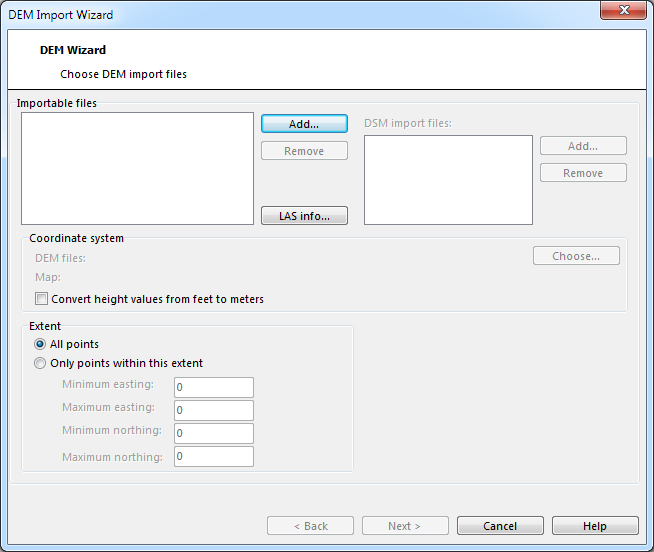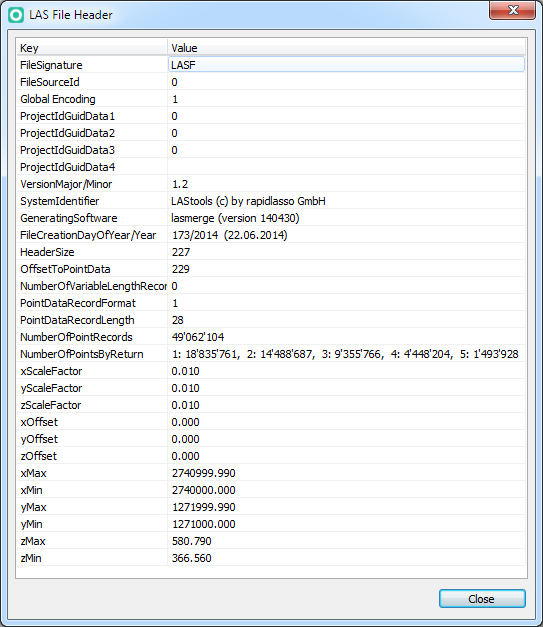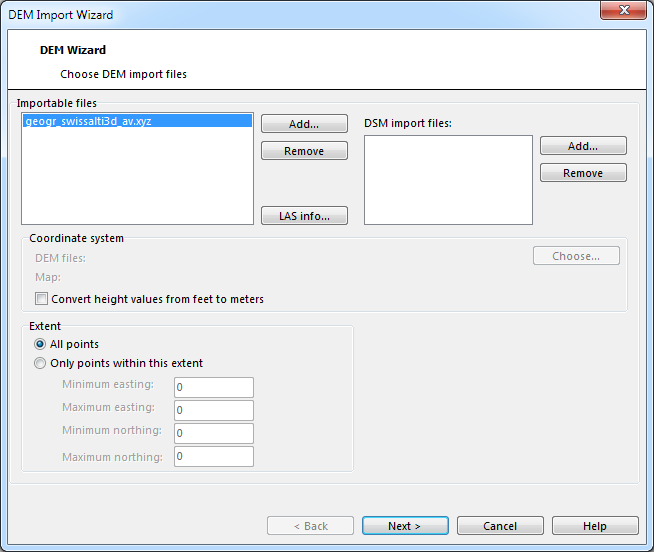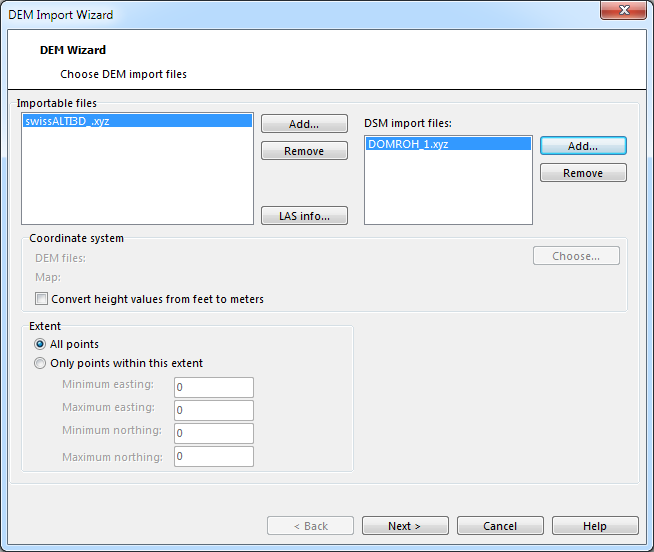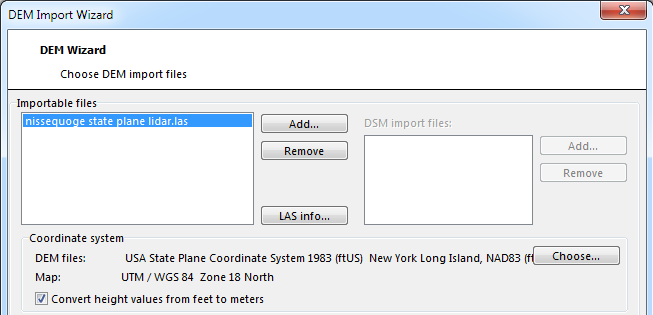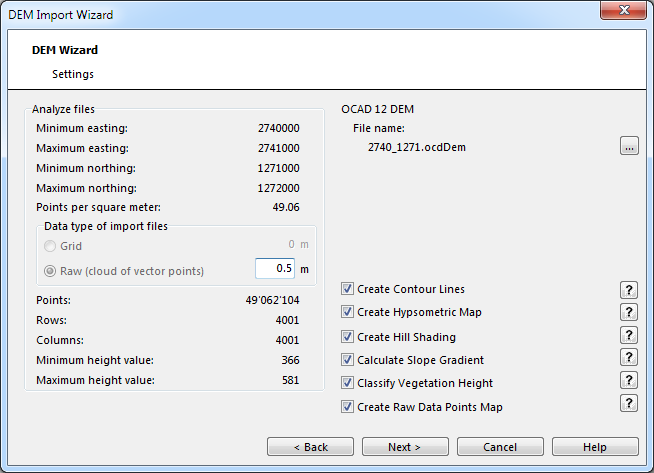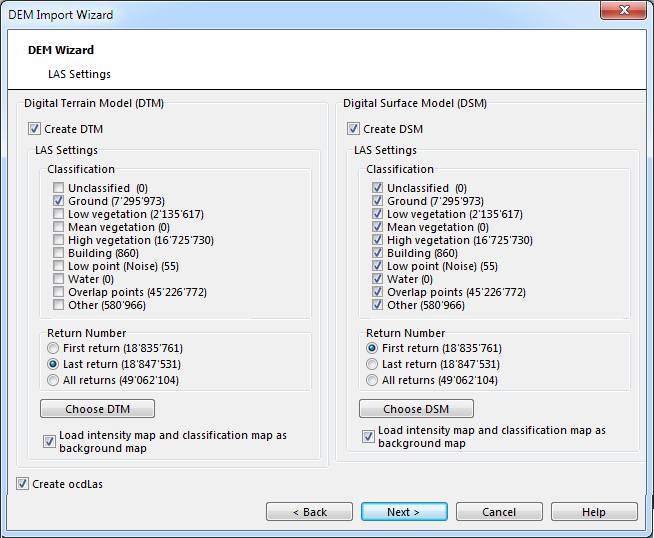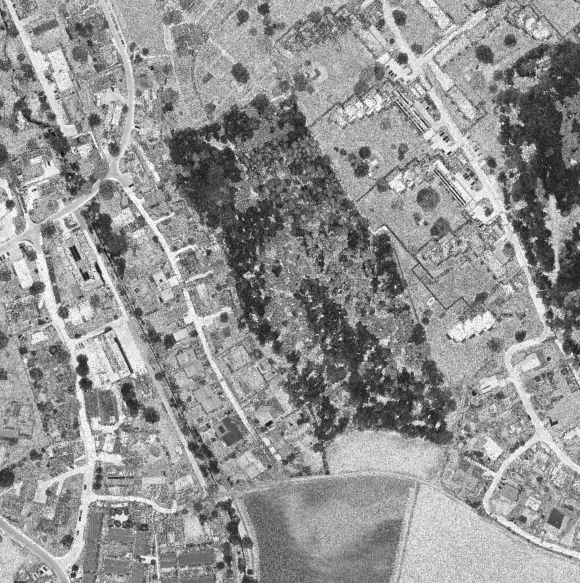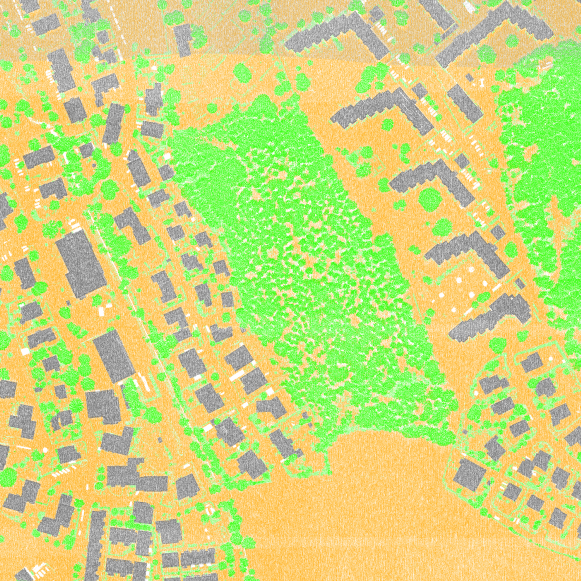DEM Import Wizard
With this DEM Import Wizard you can import DEM data and create the following output formats:
- Contour lines
- Hypsometric map
- Hill shading map
- Slope gradient map
- Vegetation height map
- Raw data points map
- Intensity map
- Classification map
DEM Import Data 


The DEM Import Wizard is able to import files with regular and irregular DEM data. Supported DEM data formats are:
- ESRI ASCII Grid (*.asc)
- Raw data ASCII XYZ file (*.xyz)
- ASCII Grid XYZ file (*.xyz)
- LAS file (*.las)
- compressed LAS file (*.laz or *.zlas)
- SRTM file (*.hgt)
laz and zLas Files
laz and zLas files are compressed LAS file.
OCAD uses the laszip.exe and LASliberator tools form Martin Isenburg to decompress the laz and zLas files.
SRTM Files
This is a world wide available DEM data set from the Shuttle Radar Topography Mission (SRTM). SRTM hgt data import requires that a coordinate system set in the OCAD map file.
Link: https://lta.cr.usgs.gov/SRTM1Arc
Start Import DEM Wizard
Select Import from the DEM menu. The DEM Import Wizard appears. Otherwise you can also drag and drop an DEM file from Windows File Explorer onto the OCAD drawing area.
First use Add button to add at least 1 DEM to the DEM Import Wizard dialog. You have three different options:
- Choose a las files which often contain DTM and DSM data
- Choose only DTM data
- Choose DTM and DSM data
Choose las Files
- After adding a las file you can select the item and click the LAS Info button. The LAS File Header dialog opens wich shows the information from the file header like the Number of Points by Return or the Extent.
Choose DTM Data
Add only the DTM file(s).
Please note that not all functions (e.g. vegetation height) are available if only DTM data are available.
Choose DTM and DSM Data
Add the DTM file(s) on the left side and the DSM file(s) on the right.
If the DSM have an other extent than the DTM then OCAD cuts to the DSM to the extent of the DTM or the choosen extent.
Coordinate System
Usually the DEM data are in the same coordinate system as the OCAD map. So no transformation is necessary.
OCAD supports the transformation during the DEM import. Click the Choose button to select the coordinate system of the DEM data.
In this example OCAD transform the DEM data from US State Plane (Feet) to the metric UTM Zone 18 North.
Optional it is possible to convert also the height values from Feet to Meters.
Extent
DEM data are often big. So the calculation needs needs a lot of time and memory. If you do not need the whole extent of DEM data you can enter here the used extent.
Please note that when an object is selected in the drawing area and you open the DEM Import Wizard, OCAD used the extent of the selected object as default extent.
Click the Next button. OCAD imports the file(s). Depends on the file size of data this step can takes some minutes. The Settings dialog appears.
Settings
This dialog shows the information about the DEM data.
Analyze Files
OCAD shows here the information about the map extent and the average number of point per square meter.
If the source file is a regular grid (data type of import files = grid), the Cell size box is set to read only. OCAD sets the same cell size for the imported DEM. For irregular DEM data source (data type of import files = raw) the cell size can be set in the 'cell size' box. For these DEM's OCAD interpolates a regular grid with the specified cell size during the import. The cell size depends on the import data and the further usage of the DEM.
![]() The Cell size range is between 0.01 and 650 m.
The Cell size range is between 0.01 and 650 m.
File Name
During the import procedure the imported DEM must be saved in the OCAD DEM file format (*.ocdDem) and it is loaded to the OCAD map.
Choose here the file name of this DEM file.
If only one import file is choosen OCAD uses by default the file name of the import file. Otherwise the filename of the ocd map.
If the ocd file is untiteled OCAD exports the DEM files in the temporary user directory (C:\Users\XXX\AppData\Roaming\OCAD\OCAD 12\Tmp).
Options
OCAD can create different outputs depending on the choosen import data type (DTM and DSM or only DTM).
Check or uncheck these outputs. OCAD shows for each output a page with options later in the DEM Import Wizard.
LAS Settings
The LAS Settings dialog is only visble when importing las/laz/zlas files.
On the left side OCAD shows the information about the DTM, on the right to the DSM. If is possible to create both DEMs in one step or only one DEM.
Each point is classified. The value in the round brackets is the number of points for this classification.
- Click the Choose DTM button to reset the Classification ans Return Number option to the default values.
- Click the Choose DSM button to reset the Classification ans Return Number option to the default values.
Usually the default setting are right. But in some cases it makes sense to uncheck the overlap point for the DSM. It depends on the data.
Create Intensity and Classification Map
Check the option Create intensity and classification map to create these maps. If created OCAD loads these raster maps as background maps.
Intensity Map
Each data point has an intensity of the returned laser beam. This intensity is shown in a grayscale map.
Example:
Classification Map
Each data point has a classification or is unclassified. This intensity is shown in a colored map.
Example:
The classification tiff image has the following color index:
- 0 Created, never classified (light gray)
- 1 unclassified (red)
- 2 Ground (yellow)
- 3 Low Vegetation (light green)
- 4 Medium Vegetation (green)
- 5 High Vegetation (dark green)
- 6 Building (Generic) (gray)
- 7 Low point (noise) (gray)
- 9 Water (blue)
- 10 Bridge (brown)
- 11 Road (brown)
- 12 Overlap pointd (gray)
Create ocdLas
Check this option to create an ocdLas file. This is an file which is optimize for OCAD and contains all points with attribute.
This file is used to create profiles. This file is often very big (> 1 GB). That is the reason why OCAD doesn't load this file by default.
Learn more about the ocdLas File functions on the ocdLas File page.
